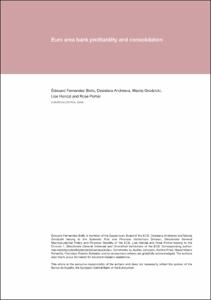Euro area bank profitability and consolidation
Autor
Fecha de publicación
24-may-2021
Descripción física
28 p.
Resumen
La consolidación del sector bancario del área del euro ha avanzado con lentitud desde que terminó la crisis financiera global, pese a la persistente debilidad de la rentabilidad bancaria. La pandemia de coronavirus (COVID-19) ha acrecentado los riesgos para la rentabilidad de este sector en el área del euro, y ha coincidido con una peor evolución de algunos bancos, en especial de aquellos con un nivel excesivo de préstamos dudosos acumulados. La consolidación de entidades bancarias puede reportar beneficios desde la perspectiva tanto micro- como macroprudencial, mediante la generación de sinergias de costes, una mayor diversificación de los ingresos y el fortalecimiento de la resiliencia del sector bancario. No obstante, este proceso comporta riesgos de ejecución que los bancos deben gestionar de forma adecuada. La consolidación puede dar lugar a problemas de competencia, aunque la evidencia empírica sugiere que en algunos países del área del euro hay margen para una mayor concentración nacional, y también para aumentar la integración transfronteriza del mercado bancario europeo. Las fusiones bancarias también incrementan la huella sistémica de las entidades resultantes, que podría afrontarse con los marcos macroprudenciales y de resolución existentes. El Banco Central Europeo analiza las consolidaciones desde una perspectiva prudencial, y centra la atención en la capacidad actual y futura de la entidad combinada para cumplir los requerimientos prudenciales. A tal fin, en enero de 2021 publicó una Guía en la que aclara sus expectativas y su enfoque en relación con tres aspectos prudenciales clave que se plantean en el contexto de las consolidaciones: la determinación de los requerimientos de capital de Pilar 2, el tratamiento del fondo de comercio negativo (badwill) y el uso de modelos internos.
Consolidation in the euro area banking sector has been slow since the end of the global financial crisis, despite the persistent weak bank profitability. The coronavirus (COVID-19) pandemic has reinforced profitability risks in the euro area banking sector, and coincided with worse performance of some banks, notably those burdened with legacy non-performing loans. Consolidation among banks may bring benefits from both a micro- and a macroprudential perspective by generating cost synergies, increasing revenue diversification and strengthening the resilience of the banking sector. However, it comes with attendant execution risks, which need to be properly managed by banks. Consolidation may give rise to competition concerns, although empirical evidence suggests that there is room for further domestic concentration in some euro area countries and for greater cross-border integration of the European banking market. Bank mergers also increase the systemic footprint of the resulting institutions, which might be addressed by the existing macroprudential and resolution frameworks. The European Central Bank assesses consolidation from a prudential perspective, focusing on the current and future ability of the combined bank to comply with prudential requirements. To this end, it published a Guide in January 2021 in which it clarified its expectations and approach to three key prudential issues arising in the context of consolidation: setting Pillar 2 capital requirements, treatment of badwill and use of internal models.
Consolidation in the euro area banking sector has been slow since the end of the global financial crisis, despite the persistent weak bank profitability. The coronavirus (COVID-19) pandemic has reinforced profitability risks in the euro area banking sector, and coincided with worse performance of some banks, notably those burdened with legacy non-performing loans. Consolidation among banks may bring benefits from both a micro- and a macroprudential perspective by generating cost synergies, increasing revenue diversification and strengthening the resilience of the banking sector. However, it comes with attendant execution risks, which need to be properly managed by banks. Consolidation may give rise to competition concerns, although empirical evidence suggests that there is room for further domestic concentration in some euro area countries and for greater cross-border integration of the European banking market. Bank mergers also increase the systemic footprint of the resulting institutions, which might be addressed by the existing macroprudential and resolution frameworks. The European Central Bank assesses consolidation from a prudential perspective, focusing on the current and future ability of the combined bank to comply with prudential requirements. To this end, it published a Guide in January 2021 in which it clarified its expectations and approach to three key prudential issues arising in the context of consolidation: setting Pillar 2 capital requirements, treatment of badwill and use of internal models.
Notas
Artículo de revista
Publicado en
Revista de Estabilidad Financiera / Banco de España, 40 (primavera 2021), p. 91-118
Otras versiones
Materias
Regulación y supervisión de instituciones financieras; Instituciones crediticias de depósito; Zona euro
Aparece en las colecciones:












